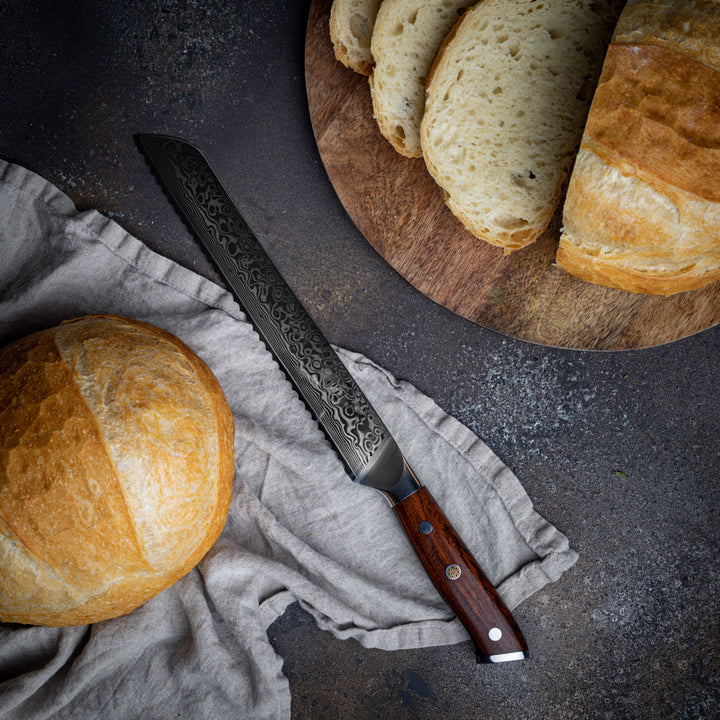The task of sharpening a bread knife might seem daunting, especially with its serrated edge. However, learning how to sharpen a bread knife with a steel is a vital skill for kitchen professionals and anyone who loves baking. Knowing the proper technique can save you time and effort while extending the lifespan of your trusty bread knife.

Why Sharpening a Bread Knife is Important
Sharp knives make clean, precise cuts, reducing the chance of accidents. When it comes to bread knives, keeping the serrations sharp is crucial for slicing through crusty loaves without squashing the bread’s soft interior.
The Benefits of a Sharp Bread Knife
- More efficient cutting
- Cleaner slices
- Reduced risk of injury
- Longer knife lifespan

Understanding Your Bread Knife
The Design of a Bread Knife
Bread knives typically feature a long, narrow blade with serrations. These teeth-like edges help the knife grip and slice through tough crusts.
Types of Serrations
There are variations in serration designs, including pointed teeth and scalloped edges. It’s essential to identify the type of serration on your bread knife before sharpening.
Materials Used in Bread Knives
Bread knives are made from various materials like stainless steel, carbon steel, and ceramic. Understanding your knife’s material is crucial for choosing the right sharpening method and tools.

Tools You Need to Sharpen a Bread Knife with a Steel
Sharpening Steel
A sharpening steel is a long rod made of hardened steel. It realigns the knife’s edge and sharpens it effectively. Not all steels are the same; some are smooth, some are ridged, and some have a diamond coating for extra effectiveness.
Types of Sharpening Steels
- Traditional Honing Steel
- Diamond-Covered Steel
- Ceramic Honing Rod
Additional Tools
- Protective gloves
- Microfiber cloth

Steps to Sharpen a Bread Knife with a Steel
Step 1: Preparation
Before you start sharpening, ensure you have a clean working space. Wear protective gloves to protect your hands during the sharpening process.
Step 2: Cleaning the Knife
Ensure that the bread knife is devoid of crumbs or debris. You can refer to this guide on cleaning knives for proper cleaning techniques.
Step 3: Positioning
Hold the sharpening steel vertically with the tip resting on a non-slip surface. Hold the knife at a slight angle to the steel, matching the angle of the serrations.
Step 4: Sharpening the Serrations
Run each serration individually down the steel, maintaining a consistent angle. Repeat this process a few times for each tooth until they are sharp.
Step 5: Honing the Knife
Once the serrations are sharpened, hone the knife by lightly running both sides along the steel.
Common Mistakes to Avoid
Using the Wrong Angle
Maintaining the correct angle is crucial. An incorrect angle can dull the knife quickly.
Skipping Serrations
Ensure each serration is sharpened. Missing any can lead to uneven cutting performance.
Not Honing After Sharpening
Skipping the honing step reduces the effectiveness of the sharpening process.
Maintaining Your Bread Knife
Regular Cleaning
Keep your bread knife clean and dry to prevent rust and corrosion. Regular cleaning enhances the longevity of the knife.
Proper Storage
Store your knife in a knife block or magnetic strip to keep the blade edge safely protected.
Frequently Asked Questions
How often should I sharpen my bread knife?
It depends on usage. For regular home use, sharpening every six months should suffice. For professionals, monthly sharpening may be necessary.
Can I use a regular sharpening stone?
A regular sharpening stone is not recommended for serrated knives as it may damage the serrations. A sharpening steel is better suited for this task.
What if my bread knife has very fine serrations?
For knives with very fine serrations, consider using a ceramic honing rod that can fit into small serrations without damaging them.
As an Amazon Associate, I earn from qualifying purchases.
For more information on knife care and sharpening, check out other resources such as this guide on chef knives. You may also find this guide on sharpening a chef knife useful for maintaining your kitchen tools.


